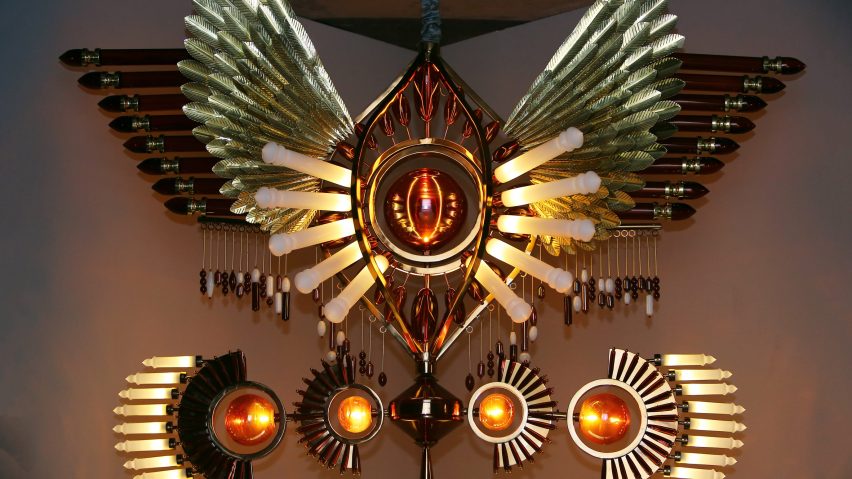This collection of illuminated "totems" designed by Indian lighting brand Klove embodies an unconventional blend of art deco and tribal references.
Created by lighting designers Prateek Jain and Gautam Seth from Klove, the Totems Over Time collection comprises 10 ornate structures made from glass and metal.
Each design makes reference to ancient tribal symbols that carry social and sacred significance for indigenous cultures, such as bows and bison horns, feathered dresses, gemstones and elaborate wings.
These age-old motifs are reimagined as symmetrical structures made up of geometric forms. According to its designers, the collection is a "nod to an 'unidentified deity'.
The light installations made their debut at the Downtown Design fair at this year's edition of Dubai Design Week, which took place from 11 to 16 November 2019.
"The Totems Over Time series is a celebration of how civilisations leave their mark across time for all mankind to experience," said Klove.
"Standing true to its name, the collection aims to 'mark its territory' by completely taking ownership of the space within which it is placed, leaving a memorable and awe-inspiring impression for everyone who witnesses it," the studio added.
In addition to four totems, the collection also features six ornate light installations informed by necklaces and ancient talismans, which have a curved form that resembles a neckline.
Designed to look like they are made up of beads, the necklace lights boast vibrant gemstone shades of emerald, ruby, jade, sapphire, topaz, pearl and onyx.
The Totems Over Time collection takes its name from the use of tribal motifs in art and design throughout history: "Totems stemmed from a natural desire to embellish using available resources and became potent symbols of clan distinctiveness," the studio explained.
According to the brand, the use of ancient tribal totems as decoration was gradually rejected in favour of classical and romantic forms of art over time.
However, after world war one, tribal motifs came back to the fore as artists and designers searched for a new aesthetic that combined indigenous traditions with industrial and mechanical advancements.
As Klove explained, this change led to a "design revolution" that we now know as art deco. It was characterised by strong, geometric shapes combined with natural symmetry, and its influence was felt across various industries including fashion, jewellery and architecture.
"Art deco is associated with a new identity of an expression of freedom, with the rise of a bold and adventurous society – giving it an impetus that is liberating," said the studio.
Klove's adoption of the art-deco aesthetic highlights the tribal influence on the movement through its use of the totem as a decorative feature and its representation of feathers using metal and bone using glass.
It sees stems of blown glass protrude from central stems like rays of light, accompanied by extravagant feather-shaped designs or illuminated horn-like forms.
Other designers also looked back to historic designs when creating new structures for Dubai Design Week. MAS Architecture Studio presented an installation at the event that is based on traditional wind towers in the region – known as barjeels.
Made from 480 layers of recycled cardboard, the modern-day barjeel works in the same way as the original design, by catching wind and dragging it into the structure to cool the interior space before releasing hot air back out.

